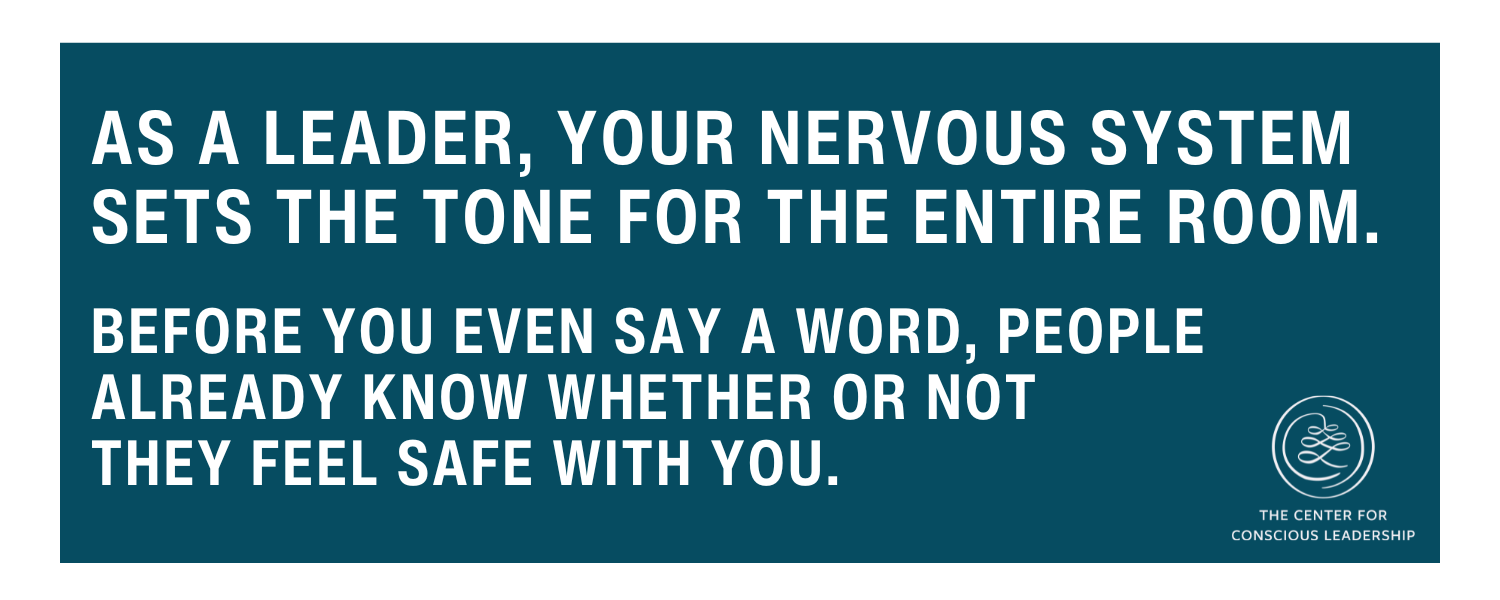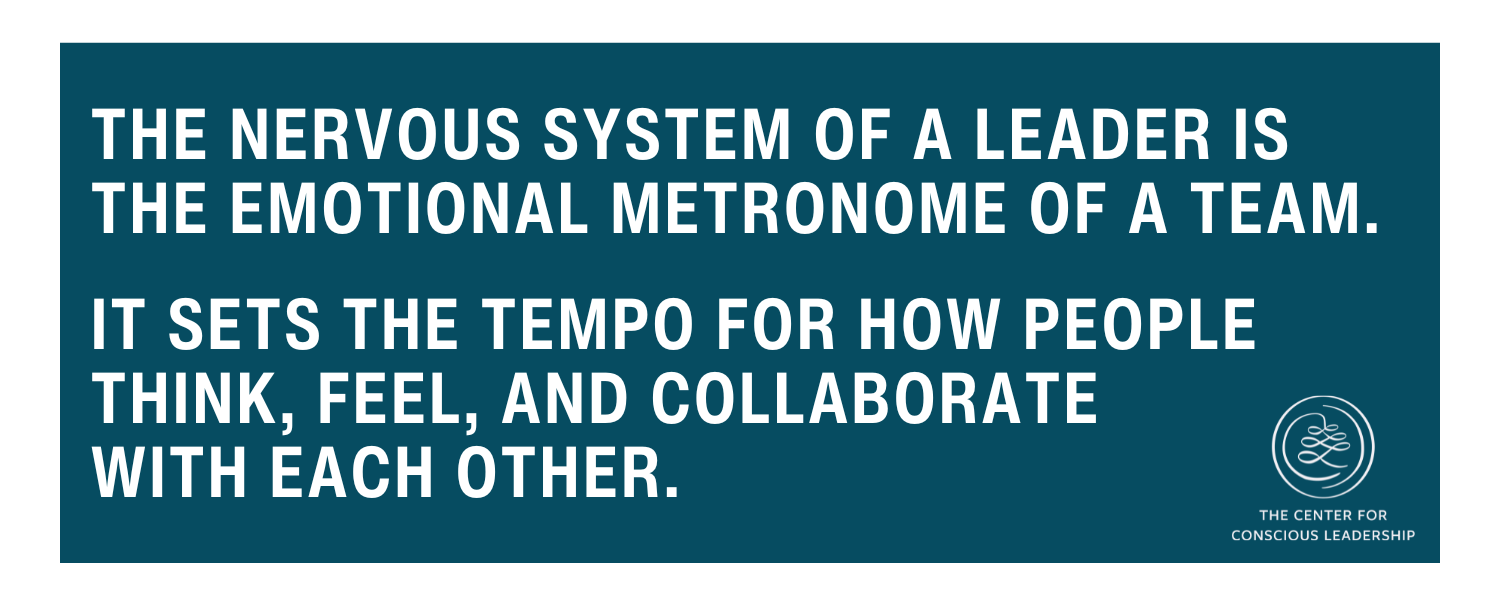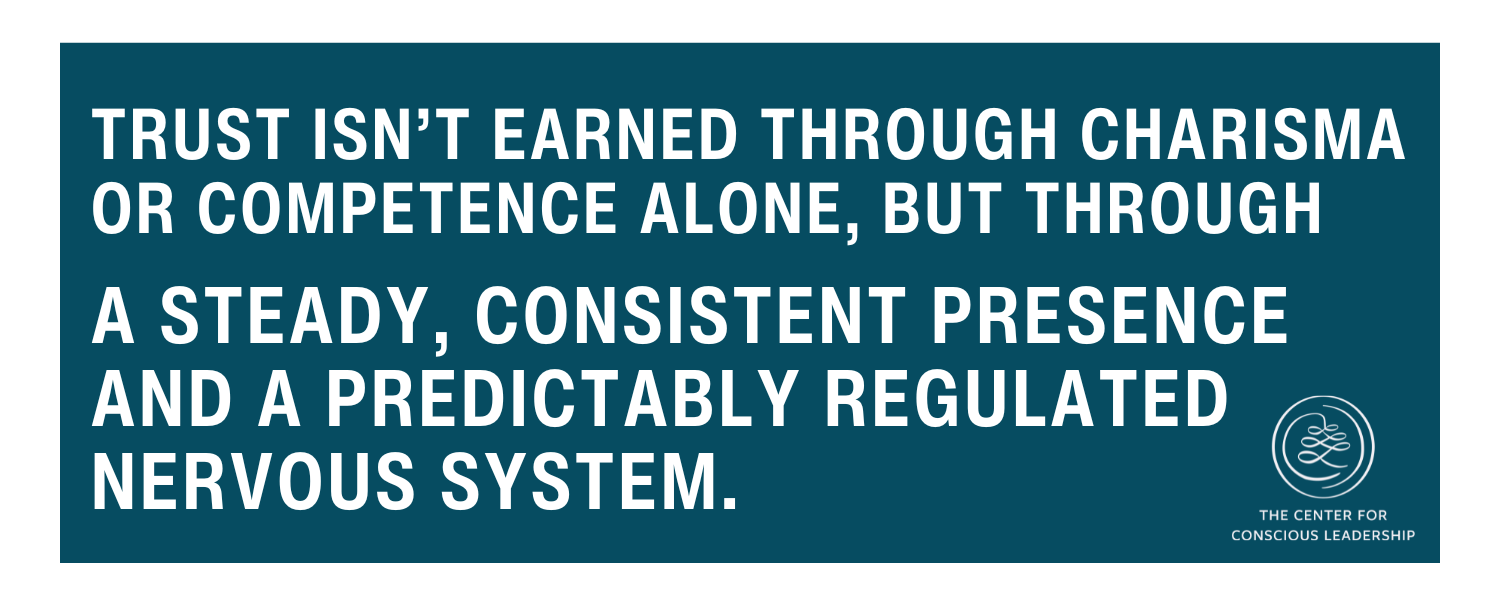The Regulation Ripple Effect: The Physiology of Executive Presence
As a leader, your nervous system sets the tone for the entire room.
Before you even say a word, people already know whether or not they feel safe with you.
When a leader walks into a meeting, the room calibrates, each nervous system shifting to match: When you’re open, curious, and ready, so are they; When you’re tense, guarded, and cautious, so are they. The subconscious signals you send through your presence are more important in shaping the culture of your organization than any strategy or values statement.
That’s the foundation of what we call The Regulation Ripple Effect—the biological process by which a leader’s internal state shapes the emotional climate of everyone around them.
Nervous Systems Under Pressure
High pressure and high stakes will naturally impact our nervous systems, but if we don’t know how to regulate ourselves, our biology will make our decisions for us. That spells chaos for our teams and organizations. When we’re scrambled and scattered, so are the systems we command and guide.
Consider Naomi, a CEO of a fast-paced startup. Right after a tough investor call, Naomi heads into an all-hands meeting, her heart still racing, breaths shallow and quick. Her words areoptimistic—We’ve got this, we’re right on track for launch!!---but her shoulders are tight and her tone is strained. Within minutes, her team’s shoulders tighten. Arms cross, and knees bounce.
Without ever addressing it, Naomi’s stress has impacted her team, taking them from open and optimistic to closed off and inexplicably nervous.
No one chooses to tense up just because their supervisor does. It happens naturally, automatically, as our nervous systems pick up on subtle signals often below our conscious awareness. But just because it’s not on purpose doesn’t mean it isn’t happening.
Now imagine Naomi, months later, after learning to calibrate before she communicates. She pauses before entering the room, breathes deeply, grounds her feet, and feels her body settle. When she speaks, her presence feels steady, open, and congruent with her message. The team never questions whether she means what she says, or whether she’s hiding something they don’t want to hear. They’re engaged, open, and attentive, exactly how she hoped they’d be.
Nothing changed in her strategy—just her state.
This is the Regulation Ripple Effect in action.
Leaders Set the Tempo and the Tone
The nervous system of a leader is the emotional metronome of a team. It sets the tempo for how people think, feel, and collaborate with each other.
Every interaction—every tone, glance, and gesture—broadcasts a biological signal to others. Before your words reach the prefrontal cortex of your team’s brains, their nervous systems have already interpreted your state as stabilizing or destabilizing, safe or not safe.
In healthy teams, the most regulated nervous system has the most influence—and that’s a good thing. A calm, grounded leader regulates everyone around her.
In toxic teams, the most dysregulated nervous system dominates—and that’s both infectious and dangerous. Reactivity and urgency become the culture’s default setting, shaping employee’s inner experience and their output.
Dysregulated teams produce less, innovate less, and fracture under pressure. Regulated teams contribute more, collaborate more easily, and build momentum that sustains itself.
That’s why the Regulation Ripple Effect matters so deeply: Trust isn’t earned through charisma or competence alone, but through a steady, consistent presence and a predictably regulated nervous system. When leaders learn to notice their internal state and consciously return to regulation, they embody safety for their people and help create the conditions for everyone to perform at their best.
The Science of Contagion
The science behind this is well-established—and deeply human.
Polyvagal Theory tells us our bodies are constantly scanning for cues of safety or danger through subtle signals like tone of voice, facial expression, and body posture. We feel whether a space is safe before we think about it.
The amygdala processes these cues in milliseconds, long before the logical brain comes online. If your tone sharpens or your eyes dart with stress, your team’s bodies register threat before your words even land.
Mirror neurons amplify this contagion. We unconsciously copy the emotional tone of those around us. In teams, this means that one person’s anxiety—or calm—quickly becomes collective.
The Window of Capacity (sometimes called the Window of Tolerance) shows that chronic stress narrows our ability to stay grounded and responsive. But co-regulation—feeling safe with another regulated nervous system—expands it again.
And finally, psychological safety research confirms what our bodies already know: high-trust teams outperform others, because leaders shape the emotional landscape of their organizations when they stay steady, calm, and regulated—especially in times of high stress or high stakes.
The Regulation Ripple Effect Framework
The good news is that you don’t need another leadership training to harness this. You need to learn how to self-regulate and co-regulate intentionally.
The Conscious Pause gives leaders a way to self-regulate, through the use of scanning, sense-making, and shaping.
The Regulation Ripple Effect Framework gives leaders a way to co-regulate intentionally. It consists of internal calibration, signaling safety, and syncing and settling back into the fabric of your team.
1. Calibration
Before you walk into a meeting, ask yourself: Am I regulated enough to lead right now?
If your own system is flooded, no strategy will land. You can’t stabilize others from a state of internal chaos.
Use the PBC tool—Pause. Breathe. Choose.
Pause to notice what’s happening inside you.
Breathe to bring your nervous system back toward equilibrium.
Choose the tone and presence you want to transmit.
Neurologist and philosopher Viktor Frankl suggests that our power to choose lies in the space between stimulus and response. What happens to us is not under our control, but our reflection on and response to this stimulus is. You can use whatever strategies work for you, including meditation, taking a walk, or reciting an affirmation. The point is to return to yourself and your Window of Capacity before making a decision.
2. Signal Safety
Once you’re feeling tethered, grounded, and regulated, you need to signal that to the people around you. Consider what your team might need from you at this moment, and what impact you want to have on their nervous systems. Is it potentially frustrating news? Be patient and understanding to communicate patience and understanding. Is it a setback in the timeline? You could try showing your confidence the project will still be as impactful as planned.
Safety signals are subtle but powerful:
Warm eye contact
Steady pacing in speech
Transparent, emotional honesty
Coherence between words and tone
We can’t fake attunement—at least, not for long.
Teams can feel whether you believe what you’re saying. When we experience a dissonance between someone’s tone and their words, we begin to distrust them, even when we don’t know why. Authentic presence—even if you admit to feeling stressed or apprehensive—builds more trust than performative calm. When we signal safety to our teams, we signal safety to the entire system—creating a larger culture of authenticity, honesty, and openness.
3. Sync & Settle
Finally, use your regulation to align with the larger group. Rather than enforcing your state on others, see what already exists within your team. Ask yourself and your team questions to determine what is coming forward, how to make meaning of it, and how to be responsive to it.
Here are a few questions you might ask:
What do we need to welcome or put aside at this moment?
What do we have capacity for today? What do we need to feel connected?
What tension needs to be cleared, or what space do we need to hold for people to take care of themselves and feel safe?
When tension arises, don’t rush to resolution. Repair first, then resolve. When we repair relational ruptures first, we show that we care about the human being we’re working with before their work and output. Syncing and settling means allowing dynamics to shift naturally, and normalizing pausing to regulate and repair in meetings together.
For example, if someone complains, “This is impossible!” Rather than correcting them immediately, validate that feeling. You could say, “I hear you–it’s a lot to juggle. What is giving you the most trouble?” or, “What support do you need from me to complete this task?” After building rapport, you can brainstorm solutions to the issue and return to baseline.
Embed this rhythm into team culture—regular pauses, genuine reflection, honest repair—and you’ll build a culture of care.
The Results
Let’s return to the CEO, Naomi.
Just days after learning about her Window of Capacity and the Regulation Ripple Effect, she begins her weekly leadership meetings with a quiet breath and a brief grounding moment.
“Let’s just take 20 seconds to settle in and arrive,” she says. The room exhales—literally.
When tough topics arise, she notices her chest tighten. She pauses, softens her tone, and invites input. Her team mirrors her composure. The meeting feels alive.
By the end of the quarter, something intangible yet undeniable has shifted. There are fewer misunderstandings and more creativity; there’s more laughter, and more trust.
The difference wasn’t her communication training or management system—it was her state.
Conscious Leadership is Regulating
We’re entering a new era of leadership—one that values presence over performance, safety over speed, and attunement over authority.
Leaders who can stay grounded in the storm, who can sense and shape the emotional field of their teams, will define the next generation of organizations.
The Regulation Ripple Effect reminds us that leadership isn’t about what you say or what you do—it’s about how you are and who you choose to be.
Small shifts in how you regulate create disproportionate impact on how your organization functions. Your steadiness becomes your team's baseline. Their capacity shapes what's possible across the system.
This is how culture changes—not through mandates, but through the compounding effect of regulated presence at every level.
When leaders regulate themselves, they don’t just change meetings. They change the operating system—the collective nervous system—of an entire organization.
If your leadership team is ready to expand its collective capacity under pressure, we can help.
Get in touch to explore how The Regulation Ripple Effect can strengthen your organization’s nervous system and revolutionize your impact–from the inside out.
The world we’re building requires leaders who are conscious, connected, and trauma-informed.
At The Center for Conscious Leadership, we help executives and organizations evolve—integrating neuroscience, trauma-informed leadership, and systems thinking to create cultures that heal and perform.
If you’re ready to build the future with us, explore our Trauma-Informed Leadership Program or connect to learn more about our coaching and systemic work.







